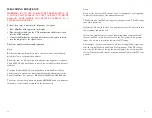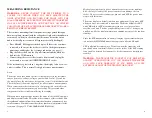
2
MEASURING DC VOLTAGE
WARNING:
DO NOT TRY TO MEASURE A VOLTAGE GREATER
THAN 1000 VOLTS DC. YOU MIGHT DAMAGE THE METER AND
EXPOSE YOURSELF TO A SEVERE SHOCK HAZARD.
Follow these steps to measure a DC voltage.
• Press
VOLTS
/
AMPS
to select voltage measurements. mV appears on
the display.
• Press
AC
/
DC
to select DC measurements.
• Plug the red test lead into the V Hz terminal, and plug the black test
lead into the COM terminal.
• Connect the probes to the circuit you want to test.
When you measure DC voltages, the minus sign appears if you connect
the black probe to a point in the circuit that has a higher voltage poten-
tial than the point where you connect the red probe.
Note: The meter does not measure DC using dBm. If you select dBm,
the meter switches to AC measurements.
MEASURING AC VOLTAGE
WARNING:
DO NOT TRY TO MEASURE A VOLTAGE GREATER
THAN 750 VOLTS AC. YOU MIGHT DAMAGE THE METER AND
EXPOSE YOURSELF TO A SEVERE SHOCK HAZARD.
Follow these steps to measure AC voltage.
• Press
VOLTS
/
AMPS
to select voltage measurements. mV appears on
the display.
• Press
AC
/
DC
to select AC measurements. [
AC
] appears on the display.
• Plug the red test lead into the V Hz terminal, and plug the black test
lead into the COM terminal.
• Connect the probes to the circuit you want to test.
• To change the readout to dBm, press
d
B
m
/
H
z
. The display changes to
show the reading in dBm. dBm replaces mV on the display.
To return to a voltage display, press
VOLTS
/
AMPS
The meter displays
the measurement in volts.
15
C
OMPARING
C
OMPONENTS
U
SING
M
IN
/M
AX
AND
H
OLD
F
UNCTIONS
To determine the range of values amongst a collection of components,
use the HOLD function in combination with MIN/MAX mode.
1.
Insert the first component in the OHMS/DIODE/CAP socket, or
attach leads appropriately.
2.
Press
AUTO
/
MAN
to set the meter to manual range mode, then set the
meter to the appropriate range. The component will be measured.
3.
Press
MIN
/
MAX
to enter the MIN/MAX mode.
4.
Press
HOLD
RELATIVE
to hold the current reading. This will prevent
the meter seeing an overrange condition in the next step.
5.
Remove the component, and attach the next component to test.
6.
Press
HOLD
RELATIVE
to release hold and measure the new component.
7.
Repeat steps
4
,
5
, and
6
until you have measured all components.
To recall the minimum and maximum measured values recorded across
all components, repeatedly press
MIN
/
MAX
. When [
MIN
] appears on the
display, the meter displays the minimum measured value. When [
MAX
]
appears on the display, the meter displays the maximum measured value.
USING THE RELATIVE FUNCTION
The relative feature lets you set a reference measurement and measure
additional values relative to the reference. For example, if you set the
reference at 100 ohms, the meter would display a 123-ohm resistor as
23 ohms, and would display a 75-ohm resistor as –25 ohms.
Follow these steps to set a reference.
• Make a reference measurement.
• While you measure the reference value, press and hold down
HOLD
/
RELATIVE
for about 2 seconds. The meter beeps. After 2 seconds, the
meter displays [
REL
] and sets the reading to 000.
The meter displays additional measurements relative to the reference
value. The meter displays values greater than the reference as positive
values and values less than the reference as negative values.
Note: You cannot use the MIN/MAX mode and the relative mode at the
same time.








